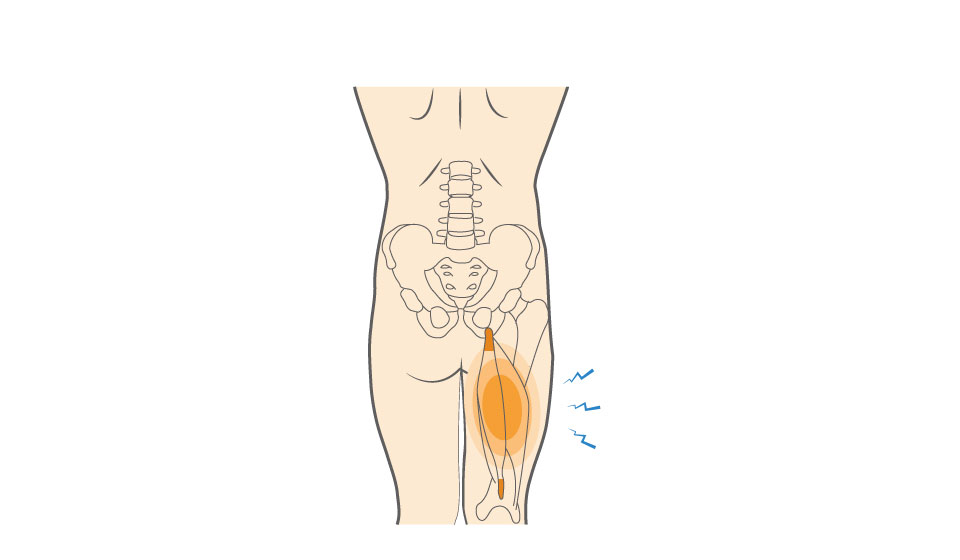The hamstrings are a group of muscles and tendons at the back of your upper leg. There are three muscles: the semitendinosus, the semimembranosus, and the biceps femoris. These are very strong muscles that are essential for jumping, running, and walking. Tendons attach the hamstring muscles to the hip bone, the shaft of the femur (the upper leg bone), and the top of the tibia and fibula (the lower leg bones). In sports, the hamstring tendons can become painfully inflamed, a condition called hamstring tendonitis.
Hamstring Tendonitis of the Hip Symptoms & Treatment Options
The hamstrings are a group of muscles and tendons at the back of your upper leg. There are three muscles: the semitendinosus, the semimembranosus, and the biceps femoris. These are very strong muscles that are essential for jumping, running, and walking. Tendons attach the hamstring muscles to the hip bone, the shaft of the femur (the upper leg bone), and the top of the tibia and fibula (the lower leg bones). In sports, the hamstring tendons can become painfully inflamed, a condition that is called hamstring tendonitis of the hip, also referred to as proximal hamstring tendinopathy in some clinical contexts.
Overview
Overview

What causes Hamstring Tendonitis of the Hip?
Hamstring tendonitis is an inflammation of the hamstring tendons. It usually results from an overuse injury or not stretching before and after you run or play. Hamstring tendonitis is also more common among older athletes and in running and cutting sports.
Hamstring tendonitis is common in these sports:
- Cross country
- Track
- Soccer
- Baseball
- Tennis
Symptoms
The main symptom experienced by athletes with hamstring tendonitis is pain in the places where the tendons attach the hamstring muscles to the bones in the leg and hip. You may feel:
- Pain either at the buttocks, along your hamstring, or at your knee (buttock pain is a common marker of proximal hamstring tendinopathy)
- Pain that is stronger when you do a move or stretch that activates your hamstrings
- Hamstring muscle weakness due to hip muscle inflammation
When to see a doctor
Make an appointment to see your doctor when you have pain in your buttocks, along your hamstring, or at your knee that doesn’t get better over time. Hamstring tendonitis of the hip may sometimes be confused with other conditions, like sciatica, so it’s important to get a correct diagnosis.
In order to make a diagnosis, your doctor will ask you about the sports you play and request that you perform certain stretches or moves. The doctor will also describe whether you feel pain. To confirm the diagnosis and rule out other conditions, your doctor may order an X-ray or magnetic resonance imaging (MRI) scan.
Non-operative treatment
Treatment for hamstring tendonitis of the hip is always non-operative. Conservative treatments may include:
- Rest from your sport and walking for long periods
- Icing the area where you feel pain
- Stretching at home, following your doctor’s recommendations
- Physical therapy while you rest from your sport, and as you begin to get more active
Try these exercises to help address your condition:
Below is a PDF of the Exercise Program
Recovery
Full recovery from hamstring tendonitis of the hip can take up to six weeks. Most athletes feel substantially better after just several days of rest, but it’s important to take it slow. Don’t restart practicing your sport until you’re given the green light by your doctor or physical therapist. Because getting back into the game too soon makes your hamstring tendons vulnerable to re-injury, allowing for the necessary time to heal will be important in the long run.
GET BACK TO WHAT YOU LOVE. FASTER
Frequently Asked Questions
How long does it typically take to diagnose hamstring tendonitis of the hip?
Diagnosis can often be made within one to two clinical visits. However, in cases where symptoms overlap with other conditions, such as hip muscle inflammation or lower back issues, additional imaging, like X-Rays or MRIs may be needed to make the diagnosis.
What is the most common reason hamstring tendonitis is misdiagnosed?
The most frequent reason for misdiagnosis is the similarity in symptoms to other conditions that cause buttock pain, such as piriformis syndrome, sciatica, or general hip muscle inflammation.
How long does treatment typically last for hamstring tendonitis of the hip?
Treatment duration varies, but most cases respond to conservative care within 4–6 weeks. Persistent or misdiagnosed cases may take several months, especially if the underlying overuse injury continues unchecked.
What are the risks of delaying treatment for proximal hamstring tendinopathy?
Delaying treatment can lead to chronic pain, further inflammation, and an increased risk of tendon rupture. Early intervention, rest, and physical therapy can help avoid long-term complications from this overuse injury.

